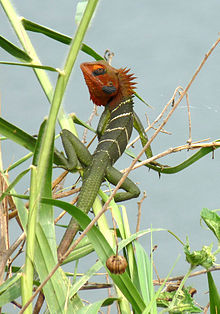- Calotes calotes
-
Common Green Forest Lizard Scientific classification Kingdom: Animalia Phylum: Chordata Class: Reptilia Order: Squamata Suborder: Iguania Family: Agamidae Genus: Calotes Species: C. calotes Binomial name Calotes calotes
(Linnaeus, 1758) [1]Synonyms - Lacerta Calotes Linnaeus, 1758
- Iguana calotes Laurenti, 1768
- Agama calotes Daudin, 1802
- Calotes ophiomachus Duméril & Bibron, 1837
The Common Green Forest Lizard (Calotes calotes) is an agamid lizard found in the forests of the Western Ghats and the Shevaroy Hills in India, and Sri Lanka.
Description
The length of head is one and a half times the size of its breadth, the snout is a little longer than the orbit. The lizard has a concave forehead, swollen cheeks and smooth, unequal upper head-scales. The canthus rostralis and the supraciliary edge both are sharp. A row of 8 or 9 compressed spines, divided into two groups, is above the tympanum, the diameter of these is less than half that of the orbit. C. calotes has 9 to 11 upper and as many lower labials. The body is compressed, the dorsal scales are large and usually feebly keeled, but sometimes smooth. these scales point backwards and upwardsand are as large as or a slightly smaller than the ventrals, which are strongly keeled and mucronate. 30 to 35 scales cover the middle of the body. The gular pouch is not developed, the gular scales are feebly keeled, they are nearly as large as the ventrals. A short oblique fold is in front of the shoulder and is covered with small granular scales. The Nuchal and dorsal crests are continuous, composed of closely set lanceolate spines with smaller ones at the base. In adult males the height of the crest on the neck equals or exceeds the diameter of the orbit, on the back it gradually diminishes in size. The Limbs are moderate, the third and fourth fingers are nearly equal, however the fourth toe is distinctly longer than third toe. The hind-limb reaches to the front of the eye or further. C. calotes has a very long and slender tail.
The lizard has a bright green dorsal coloration, usually with 5 or 6 white, cream or dark green transverse stripes, however these are changeable. Often the stripes continue on to the tail. The head is yellowish- or brownish-green whereas the male develops a bright red head and throat in the breeding season. The underside is a pale green, the tail is light brown. Young and immature sometimes have a whitish dorso-lnterr.1 stripe. A half-grown example in the British Museum, no. 74.4.29.836, has a broad vertebral stripe of buff with elongated dark brown spots.[2] It roosts on green foliage bearing trees like Azadirachta indica. Though very little knowledge is available in roosting ecology of the species.
Notes
- ^ Mohomed M. Bahir & Kalana P. Maduwage (2005). "Calotes desilvai, a new species of agamid lizard from Morningside Forest, Sri Lanka" (PDF). Raffles Bulletin of Zoology Suppl. 12: 381–392. http://rmbr.nus.edu.sg/rbz/biblio/s12/s12rbz381-392.pdf.
- ^ Smith, M A (1941) Fauna of British India. Reptilia and Amphibia.
References
- Erdelen, W. 1984 The genus Calotes (Sauria: Agamidae) in Sri Lanka: distribution patterns. J. Biogeogr. 11: 515-525
- Lönnberg, E. 1896 Linnean type-specimens of birds, reptiles, batrachians, and fishes in the Zoological Museum of the Royal University of Upsala. Bihang till Kongliga Svenska Vetenskaps-Akademiens. Handlingar, Stockholm 22 (4) l: 1-45
Categories:
Wikimedia Foundation. 2010.

